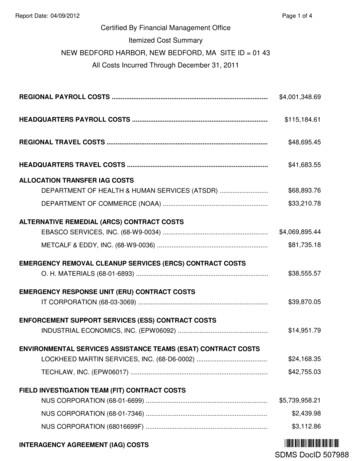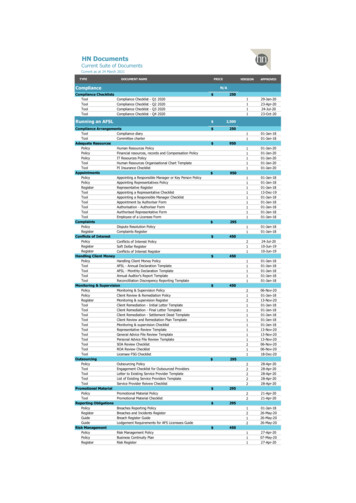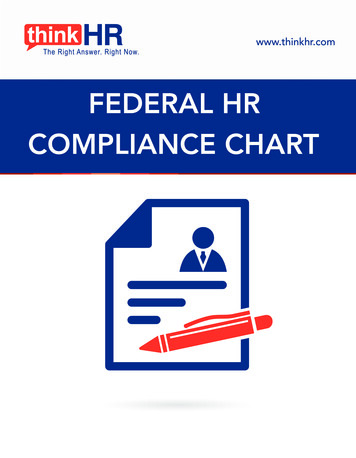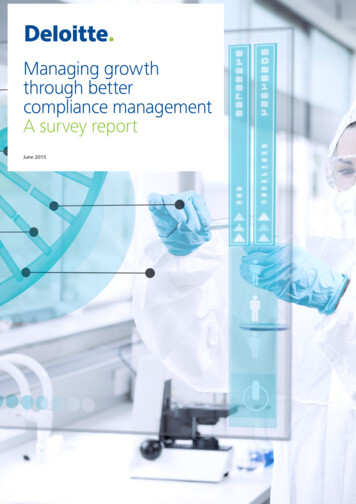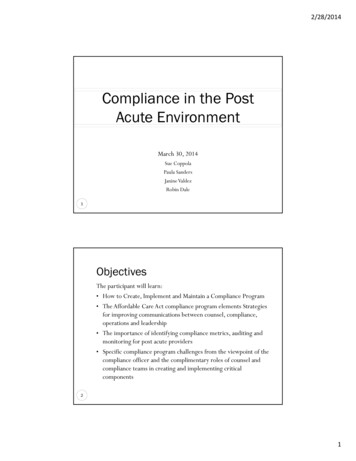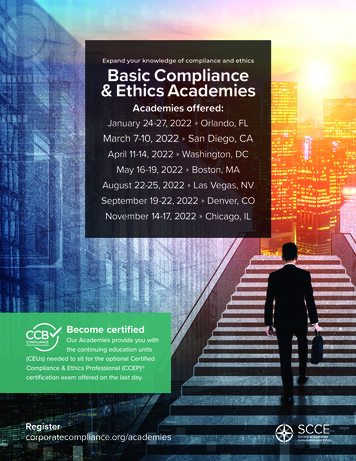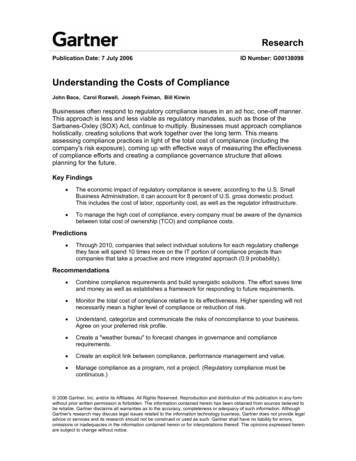
Transcription
ResearchPublication Date: 7 July 2006ID Number: G00138098Understanding the Costs of ComplianceJohn Bace, Carol Rozwell, Joseph Feiman, Bill KirwinBusinesses often respond to regulatory compliance issues in an ad hoc, one-off manner.This approach is less and less viable as regulatory mandates, such as those of theSarbanes-Oxley (SOX) Act, continue to multiply. Businesses must approach complianceholistically, creating solutions that work together over the long term. This meansassessing compliance practices in light of the total cost of compliance (including thecompany's risk exposure), coming up with effective ways of measuring the effectivenessof compliance efforts and creating a compliance governance structure that allowsplanning for the future.Key Findings The economic impact of regulatory compliance is severe; according to the U.S. SmallBusiness Administration, it can account for 8 percent of U.S. gross domestic product.This includes the cost of labor, opportunity cost, as well as the regulator infrastructure. To manage the high cost of compliance, every company must be aware of the dynamicsbetween total cost of ownership (TCO) and compliance costs.Predictions Through 2010, companies that select individual solutions for each regulatory challengethey face will spend 10 times more on the IT portion of compliance projects thancompanies that take a proactive and more integrated approach (0.9 probability).Recommendations Combine compliance requirements and build synergistic solutions. The effort saves timeand money as well as establishes a framework for responding to future requirements. Monitor the total cost of compliance relative to its effectiveness. Higher spending will notnecessarily mean a higher level of compliance or reduction of risk. Understand, categorize and communicate the risks of noncompliance to your business.Agree on your preferred risk profile. Create a "weather bureau" to forecast changes in governance and compliancerequirements. Create an explicit link between compliance, performance management and value. Manage compliance as a program, not a project. (Regulatory compliance must becontinuous.) 2006 Gartner, Inc. and/or its Affiliates. All Rights Reserved. Reproduction and distribution of this publication in any formwithout prior written permission is forbidden. The information contained herein has been obtained from sources believed tobe reliable. Gartner disclaims all warranties as to the accuracy, completeness or adequacy of such information. AlthoughGartner's research may discuss legal issues related to the information technology business, Gartner does not provide legaladvice or services and its research should not be construed or used as such. Gartner shall have no liability for errors,omissions or inadequacies in the information contained herein or for interpretations thereof. The opinions expressed hereinare subject to change without notice.
Effective compliance requires organizational support, process control methodology andcontent control. To control compliance costs, look for commonality in compliance requirements, use aninvestment approach for budgeting, and take complexity out of the system wheneverpossible.Publication Date: 7 July 2006/ID Number: G00138098 2006 Gartner, Inc. and/or its Affiliates. All Rights Reserved.Page 2 of 19
TABLE OF CONTENTS1.0 The High Cost of Compliance. 41.1 SOX and Its Impact . 52.0 Elements of Compliance Cost . 52.1 Total Cost of Ownership . 52.2 Role of Best Practices . 62.3 Assessing Risk . 62.3.1 Failure Modes and Effects Analysis . 72.3.1.1 Phases or Aspects . 72.4 Seek Additional Value From Compliance Through Aggregation. 93.0 IT Cost Drivers of Compliance Mitigation . 113.1 Complexity . 123.2 Compliance Effectiveness Related to Cost . 124.0 Managing the Cost of Compliance . 134.1 Measuring Progress Toward Compliance Using COMPARE. 144.2 Cost-Effective Compliance Requires Effective Governance . 144.3 IT Practices to Manage the Cost of Compliance. 154.4 Creating a Central Compliance Authority . 164.5 Anticipate Future Compliance Requirements. 175.0 Conclusions . 176.0 Recommendations. 18LIST OF FIGURESFigure 1. Accounts for a Compliance Cost Model . 6Figure 2. The Spectrum of Risk: What Is the Worst Credible Outcome?. 8Figure 3. FMEA Approach Applied to Compliance. 9Figure 4. Preparation and Cost of Compliance . 10Figure 5. Strike an Appropriate Balance Between Effectiveness and Efficiency . 13Figure 6. COMPARE and Key Capabilities . 14Figure 7. Components of Compliance Architecture. 16Publication Date: 7 July 2006/ID Number: G00138098 2006 Gartner, Inc. and/or its Affiliates. All Rights Reserved.Page 3 of 19
STRATEGIC PLANNING ASSUMPTIONThrough 2010, companies that select individual solutions for each regulatory challenge they facewill spend 10 times more on the IT portion of compliance projects than companies that take aproactive and more integrated approach. (0.9 probability).ANALYSIS1.0 The High Cost of ComplianceThe cost of regulatory compliance is a burden that can drain the resources out of even the mostrobust and well-run business. Consider the following facts: W. Mark Crain and Thomas D. Hopkins, public policy researchers, estimate regulatorycompliance can cost as much as 7,000 annually per employee. Surveys by organizations such as RHR International, a management consulting firm,and Financial Executives International, a professional society of CFOs, indicatecompliance costs are two to three times higher than originally estimated because ofSOX Section 404 requirements. Publicly held companies with revenue of less than 1 billion are spending, on average,about 1.8 million on SOX Section 404 compliance. According to the national law firm of Foley & Lardner, companies with revenue of lessthan 1 billion are spending 2.9 million on SOX compliance. A study conducted by CRA International for the Big Four accounting companies foundfirst-year SOX 404 costs for public companies with revenue of more than 7 billionexceeded 8.5 million. Gartner's 2005 Research Compliance Survey found that IT financial compliancemanagement spending will rise between 10 percent and 15 percent of the IT budget.The compliance burden is not just limited to publicly held companies. A survey by Foley &Lardner of almost 300 boards of directors of privately held companies found that 77 percent wereconsidering adopting some forms of SOX governance, control or transparency.An October 2005 survey by Gartner found the median estimate for 2006 IT financial managementcompliance spending by all respondents was 15 percent of the IT budget, more than four timesthe 2004 estimate from the Gartner EXP CIO Insight survey. In this latest survey, the ITcompliance managers estimated 10 percent of the IT budget, while CIOs said 12.5 percent and ITprofessionals 12 percent. The estimates for IT financial management compliance spending byaudit and finance professionals were 20 percent.The respondents to the above survey — when asked, "Which describes your 2006 IT budgetplanning for financial management compliance?" — 29 percent said they received an increase intheir IT budget to pay for it. However, 16 percent told Gartner they deferred projects to pay for it.Another 16 percent reported taking money away for existing projects and areas, such asupgrades and technology refreshes. Six percent reported canceling some projects to pay forfinancial management compliance.Another recently completed survey — the 2006 Gartner EXP CIO Survey — has found verysimilar results. When asked what percentage of the IT budget was being spent on compliance,Publication Date: 7 July 2006/ID Number: G00138098 2006 Gartner, Inc. and/or its Affiliates. All Rights Reserved.Page 4 of 19
more than 1,400 CIOs estimated that nearly 12 percent of their IT budget will go towardcompliance. When asked where they see that number going in the future, they told us they expectthat figure to grow to 14.2 percent by 2009.The growth in IT spending that is coming out in the Gartner surveys and research analysis mirrorswork done by other organizations, such as Financial Executives International (FEI). Thisprofessional society of CFOs, corporate treasurers, comptrollers and other financial executiveshave been doing extensive surveys during the same period, looking at total compliance costs (notjust IT) for SOX. You can find their results at www.fei.org.The economic impact of regulatory compliance is therefore severe, representing 8 percent of U.S.gross domestic product. It is estimated that "the cost of compliance" adds 8,000 per year to thecost of goods and services purchased by most U.S. households. These are costs that are relatedto financial compliance — for example, Occupational Safety and Health Administration (OSHA),Health Insurance Portability and Accountability Act (HIPAA) and Environmental ProtectionAgency (EPA) regulations — that manufacturers, distributors, retailers and service providers mustpay to be in regulatory compliance. These costs hurt small and midsize businesses more thanlarger ones.1.1 SOX and Its ImpactCompliance legislation includes but is not limited to the well-known SOX Act, the HIPAA, and theRevised International Capital Framework (Basel II). Of these, the SOX Act has received the mostattention recently. Its goal is to restore investor confidence by ensuring a truly independent boardof directors and more accurate, detailed financial reporting. Additionally, it calls for greaterpersonal accountability of senior executives and adherence to new accounting standards.Implementing SOX has been costly, with some estimating that the cost of meeting itsrequirements is 20 times higher than what the U.S. Securities and Exchange Commissionestimated in 2003. The reasons most cited for the higher costs are: conservative interpretation ofthe rules by auditors: and uncertainty about what constitutes compliance, leading to frivolousactions, such as requiring auditors to sit on meetings just to prove the meetings occurred.A survey by the Institute of Internal Auditors (IIA) revealed that 72 percent of its members foundthe cost of meeting Section 404 attestation exceeded the benefits "somewhat" or "greatly."However, 70 percent of respondents to the IIA study said they strongly agreed that the processdirectly improved monitoring and control.2.0 Elements of Compliance Cost2.1 Total Cost of OwnershipTo manage the high cost of compliance, whether with SOX or other laws, every enterprise mustbe aware of the dynamics of TCO.The Gartner TCO methodology assesses IT costs over time. It takes into account all the costsassociated with IT investments, including capital investment, license fees, leasing costs, servicefees and internal labor costs. It includes direct (budgeted) costs, such as capital hardware andsoftware, labor operations and administrative line items. It also includes indirect (unbudgeted)costs — that is, those associated around end-user operations, peer support, casual and formallearning, self support, application development for personal business use, file and datamanagement, and downtime. The core of the TCO methodology is a chart of accounts that liststhe line items in each category and the cost to complete or procure those items (see "DefiningGartner Total Cost of Ownership").Publication Date: 7 July 2006/ID Number: G00138098 2006 Gartner, Inc. and/or its Affiliates. All Rights Reserved.Page 5 of 19
Awareness of the dynamics of TCO is crucial to managing the cost of compliance. Unfortunately,business and information systems complexities are increasing TCO faster than best practices canbe developed to mitigate those costs. Complexity grows with the growing number of compliancerequirements. These include legal regulations, such as SOX, HIPAA, environmental laws andBasel II, as well as compliance issues brought about by mergers and acquisitions, supply chaincomplexity and siloed projects.Figure 1 gives a breakdown of the elements of compliance costs from 2003 through 2006.Figure 1. Accounts for a Compliance Cost ModelIncremental Compliance Spending (%)60Consulting50SoftwareStaff and Training40IT Services30AuditingLegal and Governance20Insurance (Estimate)10Records 098-1Note: The Standard & Poor's 500 spent an incremental average of 4 million, and the next-500-largest U.S. companiesspent an average of 3 million, on compliance management in 2005.Source: Gartner (June 2006)2.2 Role of Best PracticesBy examining best practices, companies can optimize the efficiency (ratio of cost to risk) oreffectiveness (service level) of the business process. Best practices will provide indicators foroperations that are replicable, transferable and adaptable across industries. Best-practicecategories include the traditional infrastructure TCO processes, such as change management,operational management, asset administration, technology planning, process management,customer service, and training — all or some of which may impact the cost of compliance.Furthermore, best practices regarding architecture, governance and program management thatare relevant to compliance are also included in the overall TCO analysis. These features arediscussed further in Section 4.0.2.3 Assessing RiskWhen considering compliance costs, the issues of regulatory compliance require a new factor,risk, to be added to best-practice categories. Many methods for risk analysis are precise butcomplex. Look for simple methods of risk analysis — such as failure modes and effects analysisPublication Date: 7 July 2006/ID Number: G00138098 2006 Gartner, Inc. and/or its Affiliates. All Rights Reserved.Page 6 of 19
(FMEA) — that will provide a snapshot of where to make qualitative adjustments to your riskinvestments (see "Gartner's Simple Enterprise Risk Management Framework").2.3.1 Failure Modes and Effects AnalysisFMEA is a qualitative reasoning approach to risk analysis that focuses on three key elements:severity, probability and detectability.FMEA's roots are in testing mechanical and electrical hardware systems. However, it has beenadapted to support a wide range of industries and applications, from medical patient care tosoftware application development.As adapted to compliance, the FMEA technique has two major components. The first is that itconsiders how the failure modes of each system component — that is, noncompliance — canresult in the company's overall survivability. Second, it suggests what appropriate safeguardsmight be in place to overcome noncompliance.2.3.1.1 Phases or AspectsFMEA looks at three key areas and rates each: Severity — None to moderate to absolute Probability — Remote to average to certain Dectability — Known to potential to unknownIn Figure 2, we have a potential case of noncompliance that is average in its probability, withuncertain detectability. However, noncompliance has only a moderate impact on the organization.Looking at this potential noncompliance issue, management must ask itself, "Is this an acceptablelevel of risk?"Publication Date: 7 July 2006/ID Number: G00138098 2006 Gartner, Inc. and/or its Affiliates. All Rights Reserved.Page 7 of 19
Figure 2. The Spectrum of Risk: What Is the Worst Credible yWhat If?138098-2Source: Gartner (June 2006)Figure 3 shows how the FMEA model can be applied to assess compliance risk in an enterprisesetting. It provides a framework to explore the appropriate risk response and asks, "What is themost appropriate action, given our tolerance for risk and the severity of the noncompliance?"Publication Date: 7 July 2006/ID Number: G00138098 2006 Gartner, Inc. and/or its Affiliates. All Rights Reserved.Page 8 of 19
Figure 3. FMEA Approach Applied to ComplianceIs RiskAcceptable?NoPerform Risk SpectrumAnalysisYesStop andDocumentDetermine:Cost ource: Gartner (June 2006)2.4 Seek Additional Value From Compliance Through AggregationPre-compliance TCO attempts to capture all the costs of IT investments throughout the ITresource life cycle. Costs are accounted for during planning and acquisition, deployment,management and support, and retirement or replacement. These costs then are annualized tonormalize labor and capital costs.With the introduction of compliance requirements, management must determine the level ofcompliance desired and required, as well as taking into account the potential risk ofnoncompliance. The post-compliance TCO is based on the execution of stand-alone complianceprojects, and it drives up cost incrementally, primarily because of increased complexity (seeFigure 4).Complexity is a factor that typically increases cost. Complexity can be good if it introduces usefulnew features and can be tolerated by the business. Good complexity has a positive return oninvestment in that the new features offer corresponding business benefits. Complexity can be badif it is caused by redundancy of systems, heterogeneity of infrastructure or features that areunexploited.Publication Date: 7 July 2006/ID Number: G00138098 2006 Gartner, Inc. and/or its Affiliates. All Rights Reserved.Page 9 of 19
Figure 4. Preparation and Cost of ComplianceRisk PremiumRisk Premium (Low)Risk PremiumRisk PremiumRisk Premium(Moderate)Applications IT Processes IT InfrastructurePhase 0Compliance/Governance Program Compliance ArchitectureBusiness ProcessesPost-complianceTCO — ProjectApproachCOMPARE MethodologyPre-complianceTCOCompliance Projects InitiatedBusiness as UsualRisk Premium(Critical)Risk PremiumRiskPremiumPost-complianceTCO — ProgramApproach Phase 1Phase 2138098-4Note: least expense, moderate expense and most expense.Source: Gartner (June 2006)Compliance cost and risk mitigation occur in all layers of IT. For example, the complianceenabled infrastructure level may require new security measures, new operations procedures,more-robust processing and storage management. Certainly, IT processes for changemanagement, asset management, problem and incident management, documentation, securityand auditability will need to be more mature. Applications will need more features to meet controlrequirements, and business processes will need more checks and balances to be complianceenabled. A TCO model must address the IT component of each of these layers.A compliance-enabled architecture will determine how each of these layers works together (ornot). The compliance architecture is detailed further on in this document.The compliance-enabled governance model is the business equivalent of architecture.Governance determines how decisions are made and who makes them. IT governance as asubset of corporate governance will need to have a new awareness and competency incompliance issues.Figure 4 illustrates the impact of TCO in its pre-compliance state (red) and post-compliance state(green). Note that TCO is applied to IT projects and IT operational processes. In Figure 4, weshow the day-to-day operating cost of compliance. The third block (purple) takes into account therisk adjustment that occurs as a function of the controls built into the post-compliance state. Oneway to express risk as a cost element is to estimate what it would cost to insure against a lack ofcontrols, and we have deducted that insurance cost from the post-compliance TCO. Although thisPublication Date: 7 July 2006/ID Number: G00138098 2006 Gartner, Inc. and/or its Affiliates. All Rights Reserved.Page 10 of 19
chart is for illustrative purposes only, it demonstrates the decision-making capability and impactanalysis that a TCO study can provide.3.0 IT Cost Drivers of Compliance MitigationUnderstanding what drives compliance costs allows you to capitalize on labor and investment,systems integration and standardization. Understanding these drivers also improvesmanageability.As the number of compliance projects grows, the cost of meeting those requirements growssubstantially faster. Several factors are important in controlling compliance costs: looking forcommonality; using existing and new investments; and taking as much complexity out of thesystem as possible.Looking at Gartner's formula for calculating the appropriate compliance cost for a single project,we believe:Compliance Project Sum [E*(1 lnC)]Where: E is a cost of making some project compliant when its complexity is lowest — that is, C 1 (and E of different projects could be different). C is a complexity of a separate project (and complexity of different projects could bedifferent). C varies from 1 to 10.Cost of a separate compliance project is a function of C, and is not (and should not be) a functionof the number of projects (N). Cost of compliance applied to all N projects is a function of N andC.In tackling multiple compliance projects as a program, we suggest:Compliance Program [Eave*R Eave*(1-R)*N] * (LN(1 Cave))Where: Eave is an average cost of all N projects. R is a typical percentage of the project budget that is being spent on tools andtechnology — (1-R) is a percentage of development expenses. LN is a natural logarithm. Cave is an average complexity of all N projects.We begin with the assumption that capital investment in the combined project stays the same asif it were a single project, but the development cost is a linear function of combined projects. Tocalculate the IT portion of the cost of compliance, you start by looking at the traditional direct (D)and indirect (I) IT costs. As you introduce complexity (C) in meeting compliance, those costs driveup the total of compliance rapidly. At the same time, best practices have the ability to drive outcosts, but at a much slower rate. All of this, however, is amplified by the potential risk involved innot meeting or maintaining compliance.These formulas describe and approximate the general trend that we believe is occurring. Theygive a good starting point for evaluating cost of compliance, although they could deviate from aPublication Date: 7 July 2006/ID Number: G00138098 2006 Gartner, Inc. and/or its Affiliates. All Rights Reserved.Page 11 of 19
specific project cost. However, as an approximation of a trend, they are useful, although we havenot tested them in a large number of cases.3.1 ComplexityInfrastructure TCO data shows that as complexity increases incrementally, cost rises increasinglyrapidly. When this phenomenon is coupled with a reactive project mentality, the costs will quicklybecome unmanageable. The same is true with compliance analysis, with the caveat that thecompliance issues are already much more complex than infrastructure issues.Complexity exists in the IT infrastructure and application portfolio and in the business units. Thevalue of good governance, a holistic view of compliance issues, business process simplification,and a consistent technology and business architecture will go a long way toward bettermanagement of the total cost of compliance.To reduce compliance costs, businesses must aggregate their compliance requirements, appointauthoritative leadership, allocate adequate resources and develop a detailed but unpretentiousproject plan. Compromise on any of these elements, and you will waste money, miss deadlinesand increase risks.3.2 Compliance Effectiveness Related to CostOne of the ways to evaluate the effectiveness of a compliance program is by looking at how wellit works versus how much is spent to achieve the level of compliance that management deemssufficient.Based on research by J.M. Juran and F. Gryna in "Quality Planning and Analysis," we canidentify three operational zones of compliance (see Figure 5): Unrealized potential — The compliance infrastructure is capable of cost-effectivelydelivering existing, and higher, levels of compliance. In this area, the potential exists tocost-effectively reduce compliance risk exposure by increasing the operating level ofcompliance. Risk-adjusted comfort zone — The compliance infrastructure is performing close to itsmaximum effectiveness. The objective is to maintain status quo by monitoring theevolution of costs and potential risk exposures. Inefficiency — The compliance infrastructure is incapable of cost-effectively deliveringthe required compliance level. Here, the business must think about reducing how muchit is spending on compliance and look at improving its compliance programs.Publication Date: 7 July 2006/ID Number: G00138098 2006 Gartner, Inc. and/or its Affiliates. All Rights Reserved.Page 12 of 19
Figure 5. Strike an Appropriate Balance Between Effectiveness and EfficiencyHighUnrealized PotentialInefficiencyCompliance Effectiveness Low(Level of ComplianceTotal Cost of Compliance(EffectivenessRisk-AdjustedComfort ZoneHighCompliance138098-5Source: IBM Consulting's "Risk and the Economics of Regulatory Compliance" and Gartner (June 2006)Operating at a level of compliance below that required by management's preferred risk profilejeopardizes shareholder value, reputation and revenue. There is a minimum cost required toachieve a desired level of compliance, but spending more does not necessarily mean a businessis more compliant or has reduced its risk.4.0 Managing the Cost of ComplianceAchieving compliance is merely one aspect of a series of activities that should lead to improvedrisk management and corporate performance.Today, many companies focus on meeting, attesting or maintaining regulatory requirements, suchas SOX. They may be too consumed with looming deadlines to think about the broaderimplications of the controls they are putting in place, or how these controls can be automated.However, prudent businesses will allocate resources to maintain compliance even after they havemet initial requirements. Unfortunately, previous Gartner research showed that few companieshad no annual budget designated to maintaining compliance for something such as SOX.However, as noted earlier in the latest survey data, most organizations now are budgeting ITfunds for compliance.Because compliance requirements are ongoing, all businesses will benefit from replacing a shortterm mind-set with a longer-range perspective that embraces an enterprisewide view ofcompliance. With this approach, they are more likely to respond better to volatility, focus theirattention on the risks that matter the most, identify risks they can exploit for competitiveadvantage and protect shareholder value.Publication Date: 7 July 2006/ID Number: G00138098 2006 Gartner, Inc. and/or its Affiliates. All Rights Reserved.Page 13 of 19
4.1 Measuring Progress Toward Compliance Using COMPAREAs companies struggled to reach Y2K compliance, they needed to have standardized criteria toassess their progress. At that time, Gartner introduced the Compliance Progress and Readiness(COMPARE) scale. The COMPARE scale defined levels of activity and a standard for measuringY2K compliance progress and readiness. It also laid out milestones on a scale that could be usedto evaluate any organization's process, management and progress toward neutralizing the threatfrom Y2K failures.In considering the challenges of compliance, Gartner updated a tool that could map and measureprogress. A team of analysts experienced with public policy issues, numerous compliancerequirements and IT technology organizations revisited the original COMPARE scale andreprogrammed it to focus and measure compliance activity and progress (see Figure 6).Gartner's COMPARE cycle is a well-defined, structured process and framework for complianceprojects that enables a business to measure its progress toward meeting compliancerequirements (see Section 4.2. For a detailed treatment of COMPARE, see "Use Gartner'sCOMPARE Cycle to Manage Compliance Activities").COMPARE helps businesses combine multiple compliance requirements. The result is that
Understanding the Costs of Compliance John Bace, Carol Rozwell, Joseph Feiman, Bill Kirwin Businesses often respond to regulatory compliance issues in an ad hoc, one-off manner. This approach is less and less viable as regulatory mandates, such as those of the Sarbanes-Oxley (SOX) Act, continue to multiply. Businesses must approach compliance



